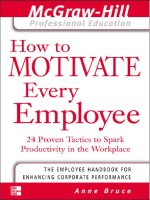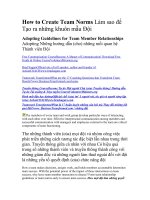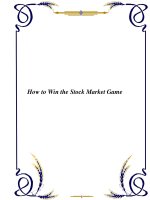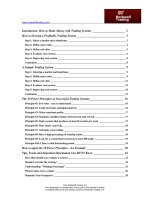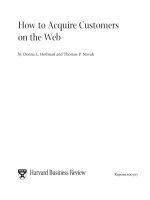Tài liệu HOW TO THINK LIKE BENJAMIN GRAHAM AND INVEST LIKE WARREN BUFFETT PART 9 pptx
Bạn đang xem bản rút gọn của tài liệu. Xem và tải ngay bản đầy đủ của tài liệu tại đây (117.08 KB, 28 trang )
243
CONCLUSION:
THE V CULTURE
R
eaders with an arbitrage orientation may regret that the exem-
plars of great modern CEOs covered in the last chapter, apart
from Warren Buffett, consist of one who is dead, one who has an-
nounced his retirement, and only one who is likely to reign for the
foreseeable future. Who’s next, and why not name them?
If I knew, I would not say. Not so much because I want to gain
a competitive edge. No, my reticence is precisely because of an in-
sight in this book: Judgment is the key, and my judgment will invar-
iably differ from yours. Our circles of competence are necessarily
different. Our interpretation of the past differs, and our prognosis
for the future must as well. It contradicts the whole point of this
book for me to tell you who I believe are the up-and-coming star
CEOs. My picks are irrelevant to your judgments.
Go back to the masters mentioned in Chapter 1 and you’ll see
that it was precisely their independence of thought, their utter and
profound common sense, which led to their remarkable success. I
condense these ideas and insights in the spirit of a teacher and pro-
fessor, not an investment adviser. I hope you’ll use these pages as a
foundation for picking stocks as a savvy, sophisticated investor (or,
failing that, picking advisers who share respect for the basic philos-
ophy of outstanding investors such as Graham and Buffett).
The basic philosophy of business analysis investing integrates
three branches: finance, accounting, and governance. Finance is
commonly defined as “the science of management of money and
other assets.” So much for this definition, if you agree that finance
is one part science and the other part art. Behavioral economics, a
field that draws on numerous disciplines, including psychology, sta-
tistics, history, and sociology, may deserve to be called a social sci-
Copyright 2001 The McGraw-Hill Companies, Inc. Click Here for Terms of Use
244
In Managers We Trust
ence. Its approach to finance is the most promising, for it recognizes
the first branch of intelligent investing: Graham’s foundational in-
sight that price and value are different things.
The meaning and measure of value are the second branch, pur-
suits requiring a grasp of basic ideas from the world of accounting.
Accounting has long been known as the language of business, and
the discretion managers have in applying accounting principles re-
quires intelligent investors to become translators of that language.
When that discretion is abused, it is safer to side with those who
declare accounting a state of mind rather than an art or science.
Fluency in accounting gives you a huge investment edge, and even
conversational accounting will put you at the top of the investing
class.
Since market prices and accounting numbers are both fragile
grounds for firm and final investment decisions, the third branch is
managerial trustworthiness. Formal and overly general governance
principles don’t help very much here. What you need are people you
are happy to entrust your wealth with. Identifying them is all art.
In the stock market forest, look for these three branches. They
enable you to steer away from the Q culture and thrive in the V
culture, a value-oriented investing culture nurtured by Graham and
Buffett.
245
NOTES
Chapter 1
1. Benjamin Graham, The Intelligent Investor (1st ed. 1949; 4th rev. ed. Harper &
Row, 1973), 108.
2. Fred Schwed, Jr., Where Are the Customers’ Yachts? (1st ed. 1940; rev. ed. John
Wiley & Sons, 1995), 6–7.
3. The New York Stock Exchange Fact Book (New York, 1999), http://
www.nyse.com; Gretchen Morgenson, “Investing’s Longtime Best Bet Is Being
Trampled by the Bulls,” The New York Times, January 15, 2000.
4. Report of the Presidential Task Force on Market Mechanisms (the Brady Re-
port), 1988.
5. Greg Ip, “Market on a High Wire,” The Wall Street Journal, January 18, 2000.
6. Burton G. Malkiel, A Random Walk Down Wall Street (1st ed. 1973; 7th rev.
ed. W. W. Norton, 1999), 57–61.
7. Warren E. Buffett and Lawrence A. Cunningham, The Essays of Warren Buffett:
Lessons for Corporate America (The Cunningham Group, 1997), 72.
8. Robert J. Shiller, Irrational Exuberance (Princeton University Press, 2000), 118–
132, catalogs and evaluates the 25 top bursts and busts on global stock ex-
changes during one- and five-year periods from the 1960s through the 1990s.
9. Joseph de la Vega, Confusio´n de Confusiones (1st ed. 1688; rev. ed. John Wiley
& Sons, 1996), 159–165 (the selected quotation condenses original material
without indicating omissions).
10. Malkiel, Random Walk,185.
11. Buffett and Cunningham, Essays, 63, 84. The price per share was $5.63, ag-
gregating $100 million, compared to a value of $400 to $500 million.
12. Graham, Intelligent Investor, 289 (footnote omitted).
Chapter 2
1. For additional analysis and sources, consult Lawrence A. Cunningham, “From
Random Walks to Chaotic Crashes: The Linear Genealogy of the Efficient
Capital Market Hypothesis,” The George Washington University Law Review,
vol. 62 (1994), on which this chapter is based.
Copyright 2001 The McGraw-Hill Companies, Inc. Click Here for Terms of Use
246
Notes
2. Louis Bachelier, “Theory of Speculation,” reprinted in The Random Character
of Stock Market Prices, Paul H. Cootner, ed. (rev. ed. MIT Press, 1964).
3. Eugene F. Fama, “The Behavior of Stock Market Prices,” Journal of Business,
vol. 38 (1965).
4. Sidney S. Alexander, “Price Movements in Speculative Markets: Trends or Ran-
dom Walks?” Industry Management Review, May 1961.
5. Benjamin Graham, The Intelligent Investor (1st ed. 1949; 4th rev. ed. Harper &
Row, 1973), 133.
6. Paul A. Samuelson, “Proof That Properly Anticipated Prices Fluctuate Ran-
domly,” Industry Management Review, Spring 1965.
7. Milton Friedman, “The Methodology of Positive Economics,” in Essays in Pos-
itive Economics (University of Chicago Press, 1953).
8. Andrew Lo and A. Craig MacKinlay, A Non-Random Walk Down Wall Street
(Princeton University Press, 1999).
9. Eugene A. Fama, “Efficient Capital Markets: II,” Journal of Finance,vol.46
(1991).
10. James Tobin, “On the Efficiency of the Financial System,” Lloyds Bank Review,
July 1984.
11. William F. Sharpe, Portfolio Theory and Capital Markets (McGraw-Hill, 1970);
Kenneth J. Arrow, “Risk Perception in Psychology and Economics,” Economic
Inquiry, vol. 20 (1982).
12. Lawrence H. Summers, “Does the Stock Market Rationally Reflect Fundamen-
tal Values?” Journal of Finance, vol. 41 (1986).
13. Fischer Black, “Noise,” Journal of Finance, vol. 41 (1986).
14. Andrei Shleifer, Inefficient Markets: An Introduction to Behavioral Finance (Ox-
ford University Press, 2000).
15. Harry M. Markowitz, Portfolio Diversification: Efficient Diversification of In-
vestments (John Wiley & Sons, 1959).
16. Sharpe, Portfolio Theory and Capital Markets.
17. Andrei Shleifer, “Do Demand Curves for Stocks Slope Down?” Journal of Fi-
nance, vol. 41 (1986).
18. Francis Fukuyama, Trust: The Social Virtues and the Creation of Prosperity (Free
Press, 1995).
19. Graham, Intelligent Investor, 61, n. 2.
20. Lawrence A. Cunningham, ed., “Conversations from the Buffett Symposium,”
Cardozo Law Review, vol. 19 (Sept.–Nov. 1997), 812.
Chapter 3
1. For additional analysis and sources, consult Lawrence A. Cunningham, “From
Random Walks to Chaotic Crashes: The Linear Genealogy of the Efficient
Capital Market Hypothesis,” The George Washington University Law Review,
vol. 62 (1994), on which this chapter is based.
Notes
247
2. H. E. Hurst, “Long-Term Storage Capacities of Reservoirs,” Transactions of the
American Society of Civil Engineers, vol. 116 (1951).
3. Edgar E. Peters, Chaos and Order in the Capital Markets (John Wiley & Sons,
1991); Edgar E. Peters, Fractal Market Analysis: Applying Chaos Theory to In-
vestment and Economics (John Wiley & Sons, 1994).
4. Henri Poincare´, Science and Method (1st ed. 1908; rev. ed. Dover Press, 1952).
5. Edward Lorenz, “Deterministic Nonperiodic Flow,” Journal of Atmospheric Sci-
ences, vol. 20 (1963); Edward Lorenz, Nonlinear Dynamical Economics and
Chaotic Motion (Springer-Verlag, 1989).
6. Alan Wolf, “Chaos in the Stadium,” Algorithm, April 1992.
7. These figures were prepared by Alan Wolf.
8. Alan Wolf, et al., “Determining Lyapunov Exponents from Time Series,” Phys-
ica, vol. 16D (1985).
9. Benoit B. Mandelbrot, The Fractal Geometry of Nature (W. H. Freeman, 1988);
Benoit B. Mandelbrot, ed., Fractals and Scaling in Finance: Discontinuity, Con-
centration, Risk (Springer-Verlag, 1997).
10. Andrei Shleifer, Inefficient Markets: An Introduction to Behavioral Finance (Ox-
ford University Press, 2000), 121–22.
11. John Y. Campbell and Robert J. Shiller, “The Dividend-Price Ratio and Expec-
tations of Future Dividends and Discount Factors,” Review of Financial Studies,
vol. 1 (1998); John Y. Campbell and John Ammer, “What Moves Stock and Bond
Markets: A Variance Decomposition for Long-Term Asset Returns,” Journal of
Finance, vol. 48 (1993).
12. Warren E. Buffett and Lawrence A. Cunningham, The Essays of Warren Buffett:
Lessons for Corporate America (The Cunningham Group, 1997), 72.
13. Warren E. Buffett, “The Superinvestors of Graham and Doddsville,” Hermes
(Columbia Business School), Fall 1984.
14. Benjamin Graham, The Intelligent Investor (1st. ed. 1949; rev. ed Harper & Row,
1973), 36–37.
15. Ibid.
Chapter 4
1. Alex Berenson, “On Hair-Trigger Wall Street, A Stock Plunges on Fake News,”
The New York Times, August 26, 2000.
2. Susan E. Hurd and Jonathan M. Winer, “On-Line Securities Fraud Under Scru-
tiny,” The New York Law Journal, February 22, 2000.
3. Professor Howard M. Friedman of the University of Toledo Law School fur-
nished testimony providing some of these examples before the Permanent In-
vestigations Subcommittee of the Senate Governmental Affairs Committee on
March 22, 1999.
4. SEC v. Francis Tribble & Sloane Fitzgerald, SEC Litigation Release No. 15959,
October 27, 1998.
248
Notes
5. SEC v. Remington-Hall Capital Corp. & Douglas T. Fonteno, SEC Litigation
Release No. 15943, October 22, 1998.
6. Alex Berenson, “Two Accused of Using E-Mail to Commit Stock Fraud,” The
New York Times, February 25, 2000.
7. Jeffrey Keegan, “Regulators Step Up Fight against Internet Fraud,” Investment
Dealers Digest, August 7, 1998.
8. Philip L. Carret, The Art of Speculation (1st ed. 1930; rev. ed. Fraser, 1984).
9. Edwin LeFe`vre, Reminiscences of a Stock Operator (1st ed. 1923; rev. ed. John
Wiley & Sons, 1994).
10. Benjamin Graham, The Intelligent Investor (1st ed. 1949; 4th rev. ed. Harper &
Row, 1973), 142.
11. Leslie Eaton, “Internet Investing: Spotlight on Risk,” International Herald Trib-
une, December 6, 1996.
12. SEC v. Aziz-Golshani, No. 99–13139 (CBM) (Federal Central District of Cali-
fornia, December 15, 1999); Rebecca Buckman and Michael Schroeder, “Web
Postings Draw Charges of Stock Fraud,” The Wall Street Journal, December 16,
1999; Gretchen Morgenson, “Internet’s Role Is Implicated in Stock Fraud,” The
New York Times, December 16, 1999.
13. SEC Litigation Release No. 16399 (January 5, 2000) (reporting on SEC v. Yun
Soo Oh Park, Federal Northern District of Illinois, Case No. 00C 0049); Jen-
nifer Friedlin, “The SEC Files Civil Fraud Charges against Tokyo Joe,” The-
Street.com & NYTimes.com, January 2000; John C. Coffee, Jr., “Tokyo Joe and
the First Amendment,” The New York Law Journal, January 20, 2000.
14. “Net Damage: PairGain Hoax Revealed,” Investor Relations Business, April 26,
1999; Associated Press, “PairGain Worker Sentenced in Fraud Case,” The New
York Times, August 31, 1999.
15. Alex Berenson, “S.E.C. Reaches Settlement in Web-Based ‘Pump and Dump’
Case,” The New York Times, March 3, 2000; Michael Schroeder, “Georgetown
Students Draw Web Investors—and an SEC Bust,” The Wall Street Journal,
March 3, 2000.
16. William M. Bulkeley, “Presstek Suit Alleges Short Sellers Posted False State-
ments On-Line,” The Wall Street Journal, September 18, 1997.
17. Gretchen Morgenson, “S.E.C. Says Teenager Had After-School Hobby: Online
Stock Fraud,” The New York Times, September 21, 2000.
18. Lawrence Harris, “Volatility, Portfolio Insurance, and the Role of Specialists
and Market Makers,” Cornell Law Review, vol. 74 (1989), provided part of the
foundation for the following discussion.
19. Michael Schroeder and Randall Smith, “Sweeping Changes in Market Struc-
ture Sought: Major Firms Propose Central Order System and Single Regulator,”
The Wall Street Journal, February 29, 2000; Alex Berenson, “Top Wall St. Ex-
ecutives Urge Trading Overhaul,” The New York Times, March 1, 2000.
20.
Michael Schroeder, “NASD, NYSE Discussed Merging to Keep Up With Mar-
ket Changes,” The Wall Street Journal, March 3, 2000; Greg Ip and Randall
Notes
249
Smith, “Instinet, Datek Recently Held Merger Talks,” The Wall Street Journal,
March 3, 2000.
21. Thomas Kalinke, “Sleepless in New York: Evening Hours at the Exchange,”
Financial History, vol. 69 (Spring 2000).
22. Rebecca Buckman, “Heavy Losses: The Rise and Collapse of a Day Trader,”
The Wall Street Journal, February 28, 2000.
23. Senate Governmental Affairs Committee, Permanent Subcommittee on Inves-
tigations, February 25, 2000; Bloomberg News, “Day Trading’s Risks and Pres-
sures Are Described to a Senate Panel,” The New York Times, February 25,
2000.
24. Gerald M. Loeb, The Battle for Investment Survival (1st ed. 1935; rev. ed. John
Wiley & Sons, 1996).
25. Warren E. Buffett and Lawrence A. Cunningham, The Essays of Warren Buffet:
Lessons for Corporate America (The Cunningham Group, 1997), 90.
26. Edward Wyatt, “Day Traders Are Formidable Market Force,” The New York
Times, April 14, 1999.
27. The Charles Schwab Corporation, 1999 Annual Report, 41–42; Patrick Mc-
Geehan, “Profit Up at Citigroup, Merrill and Schwab,” The New York Times,
April 18, 2000.
28. Patrick McGeehan, “The Unmutual Fund,” The New York Times, May 18, 2000.
Chapter 5
1. Benjamin Graham, The Intelligent Investor (1st ed. 1949; 4th rev. ed. Harper &
Row, 1973), 110.
2. Warren E. Buffett and Lawrence A. Cunningham, The Essays of Warren Buffett:
Lessons for Corporate America (The Cunningham Group, 1997), 120, 122, 134.
3. Ibid., 110.
4. John C. Bogle, Common Sense on Mutual Funds (John Wiley & Sons, 1999).
5. Gerald M. Loeb, The Battle for Investment Survival (1st ed. 1935; rev. ed. John
Wiley & Sons, 1996).
6. Buffett and Cunningham, Essays, 79; Graham, Intelligent Investor, 54, 282–
283.
7. Gretchen Morgenson, “Buying on Margin Becomes a Habit,” The New York
Times, March 24, 2000.
8. Gretchen Morgenson, “Stock-Trading Cheerleader Now Faces $45 Million
Debt,” The New York Times, April 19, 2000.
9. Nick Leeson, Rogue Trader (Warner, 1997).
10. Graham, Intelligent Investor, 228–231.
11. Buffett and Cunningham, Essays, 57.
12. Charles T. Munger, “A Lesson on Elementary, Worldly Wisdom As It Relates
to Investment Management and Business,” Outstanding Investor Digest,vol.X
(May 5, 1995).
250
Notes
13. Edwin LeFe`vre, Reminiscences of a Stock Operator (1st ed. 1923; rev. ed. John
Wiley & Sons, 1994).
14. Graham, Intelligent Investor, 245.
15. Ibid., 124–125
16. Bill Spindle, “Been There? Euphoric ’80s in Japan Ended in Long Slide,” The
Wall Street Journal, January 18, 2000.
17. Steve Liesman and Jacob M. Schlesinger, “Blunted Spike: The Price of Oil Has
Doubled This Year; So, Where’s the Recession?” The Wall Street Journal,De-
cember 15, 1999; Joseph Kahn, “Surge in Oil Prices Is Raising Specter of In-
flation Spike,” The New York Times, February 21, 2000.
18. Graham, Intelligent Investor, 162.
19. Gretchen Morgenson, “Investing’s Longtime Best Bet Is Being Trampled by the
Bulls,” The New York Times, January 15, 2000.
Chapter 6
1. Donald Schwartz, late professor at the Georgetown University Law Center,
prepared the original version of this parable, rewritten for publication here and
previously appearing in others forms in Lawrence A. Cunningham, Introductory
Accounting and Finance for Lawyers (West Group 2d ed., 1999) and Lewis D.
Solomon, et al., Corporations Law and Policy (West Group 4th ed., 1998).
2. Carol Loomis, “Mr. Buffett on the Stock Market,” Fortune, November 22, 1999.
3. Charles T. Munger, author of “A Lesson on Elementary, Worldly Wisdom As It
Relates to Investment Management and Business,” Outstanding Investor Digest,
vol. X (May 5, 1995), furnished this example.
4. Warren E. Buffett and Lawrence A. Cunningham, The Essays of Warren Buffett:
Lessons for Corporate America (The Cunningham Group, 1997), 71.
Chapter 7
1. Benjamin Graham, The Intelligent Investor (1st ed. 1949; 4th rev. ed. Harper &
Row, 1973), 63.
2. Warren E. Buffett and Lawrence A. Cunningham, The Essays of Warren Buffett:
Lessons for Corporate America (The Cunningham Group, 1997), 92–93.
3. Benjamin Graham, The Interpretation of Financial Statements (1st ed. 1937; rev.
ed. Harper Business, 1998), 77.
4. Buffett and Cunningham, Essays, 208.
5. Ibid., 91–92.
6. Adrian J. Slywotzky and David J. Morrison, authors of Profit Patterns (Times
Business, 1999), identify and discuss the patterns described in the accompa-
nying text.
7. Bill Miller, “Amazon.com’s Allure,” Barron’s, November 15, 1999.
8. Buffett and Cunningham, Essays, 96–97.
Notes
251
9. Graham, Intelligent Investor, 286.
10. Buffett and Cunningham, Essays, 99.
11. The psychology literature calls the resistance bias a “principle of conservatism”
and the pattern-seeking bias a “representativeness heuristic.” Both labels seem
not only unwieldy but imprecise when adapted for thinking about investor be-
havior. Nevertheless, investment theorists cling to these terms in arguing that
these cognitive biases play a role in explaining market inefficiencies. For an
example, consider Andrei Shleifer, Inefficient Markets: An Introduction to Be-
havioral Finance (Oxford University Press, 2000).
12. Buffett and Cunningham, Essays,87.
13. Ibid., 53.
Chapter 8
1. Leopold A. Bernstein and John J. Wild, Analysis of Financial Statements (5th
ed. McGraw-Hill, 2000), 102–03.
2. Benjamin Graham, The Interpretation of Financial Statements (1st ed. 1937; rev.
ed. Harper Business, 1998), 32.
3. For more, consult ibid. or Lawrence A. Cunningham, Introductory Accounting
and Finance for Lawyers (2nd ed. West Group, 1999), on which this and the
next chapter draw (the title is intended to show that it is for the nonaccountant;
it is not exclusively for lawyers).
Chapter 9
1. Benjamin Graham, The Intelligent Investor (1st ed. 1949; 4th rev. ed. Harper &
Row, 1973), 277.
2. Warren E. Buffett and Lawrence A. Cunningham, The Essays of Warren Buffett:
Lessons for Corporate America (The Cunningham Group, 1997), 101. Note also
Subrata N. Chakravarty, “Three Little Words,” Forbes, April 6, 1998.
3. Buffett and Cunningham, Essays,187.
4. The per share figures throughout this chapter do not take into account any
stock splits occurring in 2000 or beyond.
5. Graham, Intelligent Investor, 14–15.
6. Michael Metz and David Kerdell, “Graham and Dodd Revisited,” Portfolio Strat-
egy (CIBC Oppenheimer, December 11, 1998).
7. Benjamin Graham, The Interpretation of Financial Statements (1st ed. 1937; rev.
ed. Harper Business, 1998), 15, 23.
8. Ibid., 49.
9. Ibid., 48–49.
10. Philip L. Carret, The Art of Speculation (1st ed. 1930; rev. ed. Fraser, 1984).
11. Graham, Intelligent Investor, 277–282.
252
Notes
12. John Burr Williams, The Theory of Investment Value (1st ed. 1938; rev. ed. Fra-
ser, 1997).
13. Robert Shiller, Irrational Exuberance (Princeton University Press, 2000) (not-
ing the studies referred to and reporting on others done directly that show
slightly lower expected returns), 52–55; Graham, Intelligent Investor, 122.
14. Buffett and Cunningham, Essays,85.
15. Stern Stewart, the firm that trademarked the term “economic value added,”
publishes volumes of material on the concept, including G. Bennett Stewart
III, “EVA: Fact and Fantasy,” Journal of Applied Corporate Finance,vol.7
(1994).
16. The Coca-Cola Company defines “economic value added” in a glossary in its
annual report as year-to-year growth in after-tax operating income in excess of
a varying estimated charge for average operating capital employed.
17. Graham, Interpretation, 75–76.
Chapter 10
1. David Burgstahler and Ilia Dichev, “Earnings Management to Avoid Earnings
Decreases and Losses,” Journal of Accounting and Economics, vol. 24 (1997).
2. Michael Schroeder, “SEC to Adopt Disclosure Rules for Companies,” The Wall
Street Journal, December 16, 1999.
3. New York Stock Exchange Listed Company Manual, Section 303.01, Audit Com-
mittees (available from Big accounting firms used
these rules and recommendations to formulate statements of audit committee
standards. For example, see PriceWaterhouseCoopers, Audit Committees: Best
Practices for Protecting Shareholder Interests (1999); KMPG, Shaping the Audit
Committee Agenda (1999).
4. Graham’s lampooning appears in Warren E. Buffett and Lawrence A. Cun-
ningham, The Essays of Warren Buffett: Lessons For Corporate America (The
Cunningham Group, 1997), 159–65. Briloff’s work includes More Debits Than
Credits (Harper & Row, 1976) and Unaccountable Accounting (Harper & Row,
1972).
5. Some of these charade discussions are adapted from Lawrence A. Cunningham,
Introductory Accounting and Finance for Lawyers (2nd ed. West Group, 1999).
6. Buffett and Cunningham, Essays, 193.
7. Benjamin Graham, The Intelligent Investor (1st ed. 1949; 4th rev. ed. Harper &
Row, 1973), 167.
Chapter 11
1. Benjamin Graham, The Intelligent Investor (1st ed. 1949; 4th rev. ed. Harper &
Row, 1973), 155.
2. Ibid., 286.
3. Warren E. Buffett and Lawrence A. Cunningham, The Essays of Warren Buffett:
Notes
253
Lessons for Corporate America (The Cunningham Group, 1997), 147.
4. For additional analysis and sources, consult Lawrence A. Cunningham, “Com-
monalities and Prescriptions in the Vertical Dimension of Global Corporate
Governance,” Cornell Law Review, vol. 84 (1999), on which this and the fol-
lowing chapters draw.
5. Graham, Intelligent Investor, 270.
6. AMP, Inc. v. Allied-Signal, Inc., 1998 US District LEXIS 15617 (Federal Eastern
District of Pennsylvania, October 8, 1998), reversed on other grounds by the
Federal Third Circuit Court of Appeals, 168 Federal Reporter 3d 649 (January
20, 1999).
7. Buffett and Cunningham, Essays,47.
Chapter 12
1. Warren E. Buffett and Lawrence A. Cunningham, The Essays of Warren Buffett:
Lessons for Corporate America (The Cunningham Group, 1997), 138.
2. Ibid., 86–87, 96.
3. Roberta Romano, “Corporate Law and Corporate Governance,” Industrial and
Corporate Change, vol. 5 (1996); Sanjai Bhagat and Bernard Black, “The Un-
certain Relationship between Board Composition and Firm Performance,” Busi-
ness Lawyer, vol. 54 (1999).
4. Buffett and Cunningham, Essays, 40.
5. James A. Brickley, Jeffrey L. Coles, and Gregg Jarrell, “Leadership Structure:
Separating the CEO and Chairman of the Board,” Journal of Corporate Finance,
vol. 3 (1997).
6. Ira M. Millstein and Paul W. MacAvoy, “The Active Board of Directors and
Performance of the Large Publicly Traded Corporation,” Columbia University
Law Review, vol. 98 (1998).
7. Buffett and Cunningham, Essays, 47–54.
8. Investors Responsibility Research Center (press release), “Investors, CEOs,
Split on Best Governance Practices for Dot-Com Companies,” January 26,
2000.
9. SEC Rule 14a-8 under the Federal Securities Exchange Act of 1934.
10. Benjamin Graham, The Memoirs of the Dean of Wall Street (McGraw-Hill, 1996;
posthumous publication, Seymour Chatman, ed.), 201–212. The company was
Northern Pipeline, and the year was 1928 (Graham was 34 years old). Ibid.,
320.
11. Benjamin Graham, The Intelligent Investor (1st ed. 1949; 4th rev. ed. Harper
and Row, 1973), 270.
Chapter 13
1. Joseph Kahn, “AMP Rejects Allied Signal’s Takeover Bid of $10 Billion,” The
New York Times, August 22, 1998.
